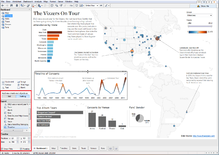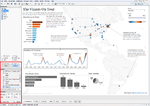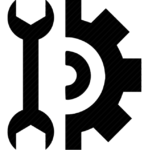Tableau Public
Tableau
The last edition of this page was on: 2014/06/27
The Completion level of this page is : Low
The last edition of this page was on: 2014/06/27 The Completion level of this page is : Low
SHORT DESCRIPTION
[[has description::Tableau software helps people communicate data through an innovation called VizQL, a visual query language that converts drag-and-drop actions into data queries, allowing users to quickly find and share insights in their data. With Tableau, “data workers” first connect to data stored in files, cubes, databases, warehouses, Hadoop technologies, and even some cloud sources like Google Analytics. They then interact with the Tableau user interface to simultaneously query the data and view the results in charts, graphs, and maps that can be arranged together on dashboards. (Jones, 2014: 15)
Basically, one has to install a desktop application (Win/Mac) and create a visualization. The result then can be published either on their public server or on your own server (commercial).]]
TOOL CHARACTERISTICS
Usability
Tool orientation
Data mining type
Manipulation type
IMPORT FORMAT : TXT
EXPORT FORMAT : HTML
| Tool objective(s) in the field of Learning Sciences | |
|
☑ Analysis & Visualisation of data |
☑ Providing feedback for supporting instructors: |
Tool can perform:
- Data extraction of type: Flat file database/Logfile extractor
- Transformation of type:
- Data analysis of type:
- Data visualisation of type: Sequential Graphic, Chart/Diagram, Map, Tag Cloud (These visualisations can be interactive and updated in "real time")
ABOUT USERS
Tool is suitable for:
Required skills:
STATISTICS: Basic
PROGRAMMING: Basic
SYSTEM ADMINISTRATION: Basic
DATA MINING MODELS: Basic
FREE TEXT
| Tool version : Tableau (blank line) Developed by : | 
|
SHORT DESCRIPTION
Tableau software helps people communicate data through an innovation called VizQL, a visual query language that converts drag-and-drop actions into data queries, allowing users to quickly find and share insights in their data. With Tableau, “data workers” first connect to data stored in files, cubes, databases, warehouses, Hadoop technologies, and even some cloud sources like Google Analytics. They then interact with the Tableau user interface to simultaneously query the data and view the results in charts, graphs, and maps that can be arranged together on dashboards. (Jones, 2014: 15)
Basically, one has to install a desktop application (Win/Mac) and create a visualization. The result then can be published either on their public server or on your own server (commercial).
TOOL CHARACTERISTICS
| Tool orientation | Data mining type | Usability |
|---|---|---|
| This tool is designed for general purpose analysis. | This tool is designed for Structured data mining. | Authors of this page consider that this tool is easy to use. |
| Data import format | Data export format |
|---|---|
| TXT. | HTML. |
| Tool objective(s) in the field of Learning Sciences | |
|
☑ Analysis & Visualisation of data |
☑ Providing feedback for supporting instructors: |
Can perform data extraction of type:
Flat file database/Logfile extractor
Can perform data transformation of type:
Can perform data analysis of type:
Can perform data visualisation of type:
Sequential Graphic, Chart/Diagram, Map, Tag Cloud (These visualisations can be interactive and updated in "real time")
ABOUT USER
| Tool is suitable for: | ||||
| Students/Learners/Consumers:☑ | Teachers/Tutors/Managers:☑ | Researchers:☑ | Organisations/Institutions/Firms:☑ | Others:☑ |
| Required skills: | |||
| Statistics: BASIC | Programming: BASIC | System administration: BASIC | Data mining models: BASIC |
OTHER TOOL INFORMATION

|
| TableauPUBLICDashboards.png |
| TableauLOGO.jpg |
| Tableau |
| Free&Closed source |
| http://www.tableausoftware.com/public/ |
| [[has description::Tableau software helps people communicate data through an innovation called VizQL, a visual query language that converts drag-and-drop actions into data queries, allowing users to quickly find and share insights in their data. With Tableau, “data workers” first connect to data stored in files, cubes, databases, warehouses, Hadoop technologies, and even some cloud sources like Google Analytics. They then interact with the Tableau user interface to simultaneously query the data and view the results in charts, graphs, and maps that can be arranged together on dashboards. (Jones, 2014: 15)
Basically, one has to install a desktop application (Win/Mac) and create a visualization. The result then can be published either on their public server or on your own server (commercial).]] |
| General analysis |
| Students/Learners/Consumers, Teachers/Tutors/Managers, Organisations/Institutions/Firms |
| Basic |
| Basic |
| Basic |
| Basic |
| Application software |
| Flat file database/Logfile extractor |
| Structured data mining |
| Data extraction, Data visualisation |
| TXT |
| HTML |
| XLS |
| Sequential Graphic, Chart/Diagram, Map, Tag Cloud |
| Visualisation is interactive, Visualisation is updated in "real time" |
| easy to use |
| Low |
There are four software products:
- Tableau Desktop (public): Can only import txt and xsl files !
- Tableau Desktop personal ($1000) and professional ($2000)
- Tableau Online
- Tableau Serveur
- Tableau Public

